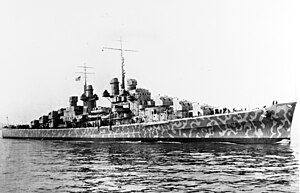 USS Juneau in February 1942.
| |
| History | |
|---|---|
| Name | Juneau |
| Namesake | City of Juneau, Alaska |
| Builder | Federal Shipbuilding and Drydock Company, Kearny, New Jersey |
| Laid down | 27 May 1940 |
| Launched | 25 October 1941 |
| Sponsored by | Mrs. Harry I. Lucas |
| Commissioned | 14 February 1942 |
| Identification | Hull symbol: CL-52 |
| Honors and awards | |
| Fate | Torpedoed and sunk by Japanese submarine I-26 during Naval Battle of Guadalcanal on 13 November 1942 Shipwreck found, 17 March 2018 |
| Notes | Approximate location of sinking: 10°34′S 161°04′E / 10.567°S 161.067°E[1] |
| General characteristics (as built)[2][3] | |
| Class and type | Atlanta-class cruiser |
| Displacement |
|
| Length | 541 ft 6 in (165.05 m) oa |
| Beam | 53 ft (16 m) |
| Draft |
|
| Installed power |
|
| Propulsion |
|
| Speed | 32.5 kn (37.4 mph; 60.2 km/h) |
| Complement | 673 officers and sailors |
| Armament |
|
| Armor |
|
USS Juneau (CL-52) was a United States Navy Atlanta-class light cruiser torpedoed and sunk at the Naval Battle of Guadalcanal on 13 November 1942. In total, 687 officers and sailors, including the five Sullivan brothers, were killed in action as a result of her sinking. Only 10 survivors were rescued after eight days in the water.[4] To honor the five Sullivan brothers and Juneau, the U.S. Navy has since commissioned two ships named USS The Sullivans and two ships named USS Juneau. On 17 March 2018, Paul Allen's research crew on board RV Petrel located the wreck of Juneau at a depth of about 4,200 m (13,800 ft) off the Solomon Islands.
- ^ Hoover, Gilbert G. (14 November 1942). "Report of Submarine Torpedo Attack on Task Unit and sinking of USS Juneau". World War II War Diaries, 1941-1945 via fold3.com.(subscription required)
- ^ Rickard, J (13 January 2015). "Atlanta Class Cruisers". Historyofwar.org. Retrieved 22 November 2015.
- ^ "US Cruisers List: US Light/Heavy/AntiAircraft Cruisers, Part 2". Hazegray.org. 24 April 2000. Retrieved 23 October 2015.
- ^ "The deaths of these 5 sailors changed how US manned military units". The Navy Times. 9 November 2019.